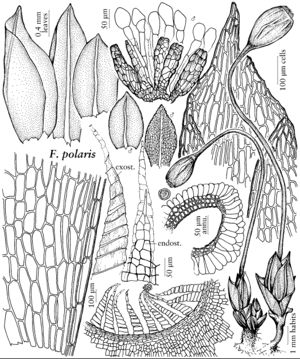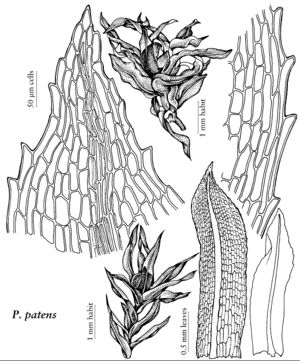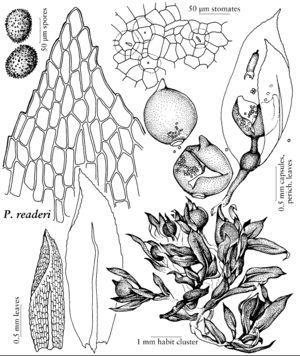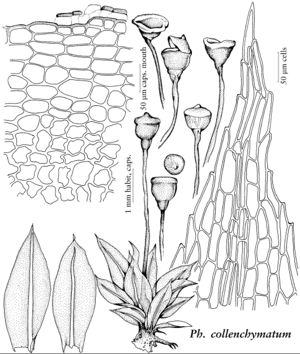Plants minute to medium-sized, gregarious to forming open tufts, light to yellow-green, annual to biennial. Stems short, erect, simple or with a few branches, central strand present, basal rhizoids few. Leaves usually larger and more crowded distally, often comose, reduced proximally, usually contorted when dry, spreading when wet, broadly elliptic to obovate, usually concave, margins plane to somewhat incurved, entire to serrate, sometimes limbate, apex acute to acuminate, rarely somewhat blunt, costa single, percurrent to excurrent; distal and median cells usually irregular-rhombic to hexagonal or rectangular, smooth and rather thin-walled, often lax, weakly chlorophyllose, proximal cells usually longer, oblong to rectangular, sometimes weakly inflated at proximal angles, differentiated alar cells absent. Specialized asexual reproduction absent. Sexual condition autoicous, sometimes polygamous, rarely synoicous or paroicous. Perigonia terminal on short basal branches, budlike, paraphyses yellowish and club-shaped. Perichaetia terminal, paraphyses usually absent and filiform when present, perichaetial leaves often somewhat enlarged. Seta terminal, solitary, short-to-elongate, erect to somewhat curved, smooth or rarely papillose. Capsule stegocarpous or cleistocarpous, immersed to exserted, globose or pyriform to cupulate, sometimes flaring, symmetric and nearly smooth to asymmetric and striate when dry, usually with a neck; exothecial cells thick to thin-walled; stomata restricted to neck, consisting of a slit in a rounded guard cell, superficial or immersed, annulus present or absent, revoluble, revoluble in fragments, or not; operculum present or absent, flat, conic-rounded, to rostrate; peristome double, single, rudimentary, or absent, exostome teeth 16, erect to incurved, papillose-striolate or striate, trabeculate on adaxial surface, endostome segments 16 and opposite the exostome teeth, cilia absent, represented only by the exostome when single. Calyptra deciduous or persistent, mitrate to cucullate, smooth, usually long-rostrate and inflated towards the base. Spores spherical or subreniform, strongly ornamented to smooth.
Distribution
Worldwide except Antarctica
Discussion
Genera ca. 13, species ca. 300 (6 genera, 29 species in the flora).
The Funariaceae is characterized by broad leaves, large, pale laminal cells, opposite peristomes, and the distinctive stomata. The majority of species are found in disturbed or open sites on bare soil. Many of the species are annuals or biennials, and some may be perennials. When sterile, only a few species have distinctive vegetative features that allow positive identification to genus or species level. Fortunately most are usually fertile and sporophytes are common, although seasonal.
Selected References
Lower Taxa
Illustrations
Key
| 1 | Calyptra large and four-angled, completely enclosing the mature capsule. | Pyramidula |
| 1 | Calyptra smaller than mature capsule, not angled or persistent | > 2 |
| 2 | Capsules immersed | > 3 |
| 2 | Capsules emergent or long-exserted | > 5 |
| 3 | Capsules rupturing irregularly; exothecial cells delicate, thin-walled. | Physcomitrella |
| 3 | Capsules operculate; exothecial cells firm, thick-walled or collenchymatous | > 4 |
| 4 | Exothecial cells collenchymatous; spores spiculose-papillose. | Aphanorrhegma |
| 4 | Exothecial cells not collenchymatous; spores papillose. | Physcomitrium |
| 5 | Capsules inclined and asymmetric; peristome double, endostome well developed to somewhat rudimentary. | Funaria |
| 5 | Capsules erect and more or less symmetric; peristome either single, rudimentary, or absent | > 6 |
| 6 | Capsules sub-cylindric to narrowly pyriform; most exothecial cells oblong to oblong-linear, rarely isodiametric; calyptra cucullate. | Entosthodon |
| 6 | Capsules urn-shaped, broadly pyriform, to cupulate; operculum rostrate; most exothecial cells irregularly hexagonal, ± isodiametric; calyptra mitrate to irregularly mitrate, sometimes appearing cucullate. | Physcomitrium |









